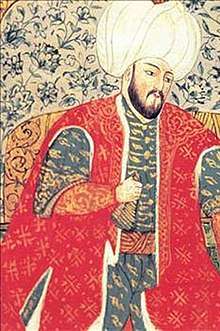Şehzade Mustafa
| Şehzade Mustafa | |
|---|---|
 An Ottoman miniature of Şehzade Mustafa | |
| Born |
1515 Manisa, Ottoman Empire |
| Died |
6 October 1553 (aged 37–38) Konya, Ottoman Empire |
| Burial | Muradiye Complex, Bursa |
| Spouse | Unnamed Crimean wife |
| Issue |
Nergisşah Sultan Şehzade Ahmed Şahihuban Sultan Şehzade Mehmed |
| Dynasty | Ottoman |
| Father | Suleiman the Magnificent |
| Mother | Mahidevran Sultan |
Şehzade Mustafa Muhlisi (Turkish pronunciation: [ʃehzaːˈde mustaˈfa muhliˈsi]; 1515 – 6 October 1553) was the eldest son of the Ottoman Sultan Suleiman the Magnificent and his consort Mahidevran Sultan. He was the prince-governor of Manisa from 1533 to 1541, of Amasya from 1541 to 1549 and of Konya from 1549 to 1553. Şehzade Mustafa was the heir apparent to the Ottoman throne and a very popular prince among the army prior to his execution, by order of his father, which he later regretted.
Life

Mustafa was born in 1515 in Manisa to Şehzade Suleiman (the future sultan) and Mahidevran.
Mustafa experienced some problems in his relationship with his father since very early in his life. He was the first-born son and therefore the heir apparent to the throne, but his father, according to some historians, was more interested in Mustafa's younger half-brother Şehzade Mehmed, the eldest son of Hürrem Sultan, the most prominent one of Suleiman's consorts and his legal wife. Suleiman created more opportunities to the younger one and appeared to be preparing him for the throne. His father's treatment further displeased Mustafa and the whole people and even Suleiman's sisters who supported Mustafa.
Mustafa was reported to be very close to his brothers Mehmed, Selim II, Bayezid & Cihangir. exemplified by the fact that Selim II treated Mahidevran like his own mother during her last years and built Mustafa's tomb at Bursa.
Then, he faced a second shock after being sent to Amasya from the more prominent Manisa. The rule of Manisa was given to Mehmed. However, after he was sent to Amasya, Mustafa got the news of an edict written by Suleiman: he had sent him to Amasya not because he did not want him to be his heir, but in order to defend the east coast of the Ottoman Empire and learn how to manage a large empire.[1] This edict also relieved the Ottoman army and people, as Şehzade Mustafa was the popular successor to the throne.
In Amasya, he got the news of the death of his brother Mehmed. It seemed like all barriers between the throne and Mustafa were gone, but he still faced another challenge. Another brother of Mustafa, Şehzade Bayezid, was sent to Konya for his sanjak assignment.
It was a critical decision, as they were Hürrem Sultan's sons, the mother of the late Mehmed. Her support of her own son, made Mustafa's political career difficult, but he successfully ruled Amasya for 12 years.
In 1547, during Sultan Suleiman’s Elkas Campaign, the sultan met with his sons Selim, Bayezid, and Mustafa in different places and talked to them about the political situation. It was long after the death of Mehmed, but the race between the three princes was still going on. Selim was sent to Anatolia as the prince of Manisa in 1544
In 1549, as a reward for his excellent participation in the Ottoman-Safavid War, Mustafa moved to Konya for his sanjak assignment.[2] The rumours and speculations say that Mustafa’s life was now in danger, as Hürrem and Rüstem Pasha had made a court alliance against him in favor of Hürrem's sons, Selim and Bayezid.
Execution

During Suleiman’s Persian campaign, his army halted in Ereğli for a while. While Suleiman's army was in Ereğli, Rüstem Pasha made an offer to Mustafa to join his father’s army. At the same time he warned Suleiman and persuaded him that Mustafa was coming to kill him.[3]
Mustafa accepted Rüstem Pasha’s offer and assembled his army to join his father's. Suleiman saw this as a threat and ordered the execution of his son. When Mustafa entered his father’s tent to meet with him, Suleiman's guards attacked Mustafa, and after a long struggle they killed him using a bow-string.[4]
Consort and children
In 1535, Mustafa married unnamed woman of Crimean origin and had several children:[5]
- Nergisşah Sultan (1536, Manisa – 1592, Ankara). Mustafa's favorite daughter. She was married in 1555 to Damat Cenabi Ahmet Pasha, governor of Anatolia. She was buried in her father's tomb.
- Şehzade Ahmed (1538 – 1552, Konya).
- Şahihuban Sultan (1540, Manisa – October 1577). She was married in 1555 to Damat Abdülkerim Pasha, Amasya's governor.
- Şehzade Mehmed (1546, Amasya – 1553, Bursa). Following his father's execution, Mehmed was also executed as his grandfather Suleiman had considered him a potential threat. He's buried in Mustafa's tomb.[5]
Depictions in literature and popular culture
In 1561, eight years after Mustafa's death, the French author Gabriel Bounin wrote a tragedy titled La Soltane about the role of Hürrem Sultan in Mustafa's death.[6] This tragedy marks the first time the Ottomans were introduced on stage in France.[7]
In the television series Muhteşem Yüzyıl, Mustafa is played by Turkish actor Mehmet Günsür.
References
- ↑ Afyoncu, Erhan (2012). Şehzade Mustafa. Atlas Tarih.
- ↑ Sakaoğlu, Necdet; Bu Mülkün Sultanları, page 137.
- ↑ Beosch, Moritz. The Height of the Ottoman Power; Murder of Prince Mustafa
- ↑ A General History of the Middle East, Chapter 13: Ottoman Era, Suleiman the Magnificent
- 1 2 Yılmaz Öztuna, Kanuni Sultan Süleyman (Pages: 174-189), Babıali Kültür Publications, 2006
- ↑ The Literature of the French Renaissance by Arthur Augustus Tilley, p.87
- ↑ The Penny cyclopædia of the Society for the Diffusion of Useful Knowledge p.418
